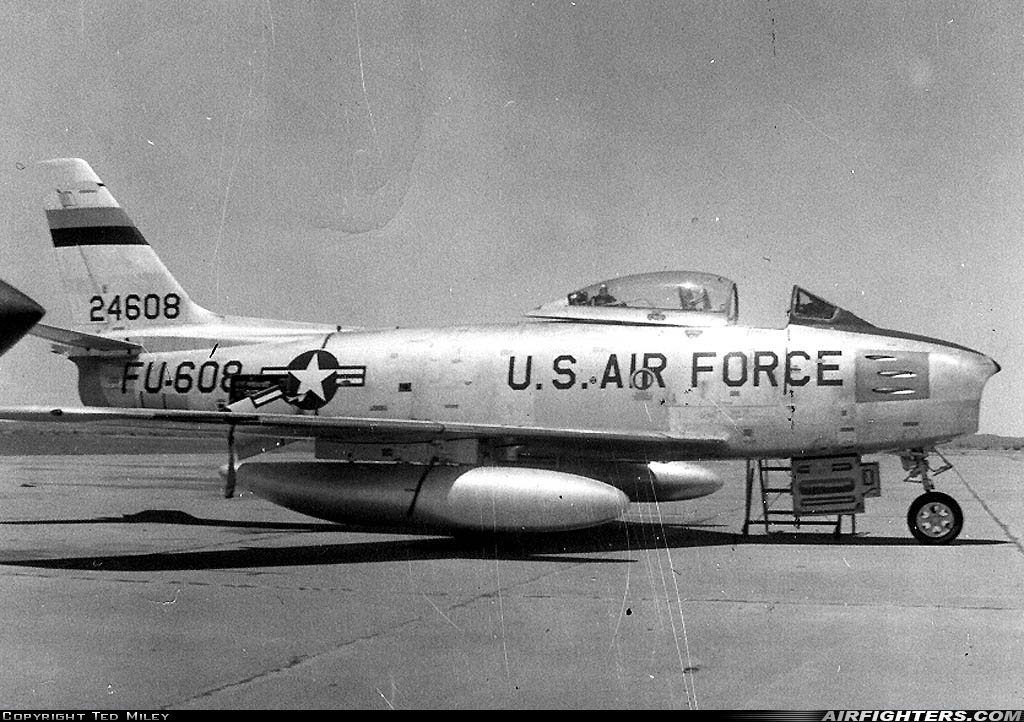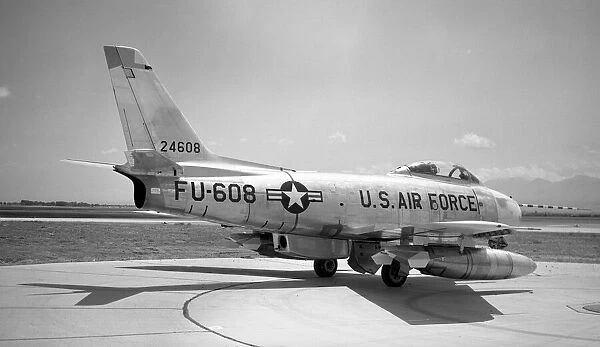In the heart of the California Central Coast’s wine country sits Paso Robles, whose local airport is the home of the Estrella Warbirds Museum, one of the most extensive collections of aircraft and an equally extensive automobile collection in the form of the Woodland Auto Collection (for details about the museum in general, visit this article HERE). But this past month, the museum made a significant addition to its collection in the form of a rare experimental version of the North American F-86F Sabre, which had been held in storage for decades prior to this point, and will now be restored for display at the museum. The Sabre in question was originally manufactured at North American Aviation (NAA)’s factory in Inglewood, CA as construction number 191-304 and accepted into the US Air Force as 52-4608 on March 11, 1953. It was originally assigned to the 81st Fighter-Bomber Squadron (FBS), 50th Fighter-Bomber Group (FBG) at Clovis AFB, NM. Later, it would serve at foreign US air bases, from Hahn Air Base in West Germany to Wheelus in Libya before being reassigned to the 4350th Combat Crew Training Wing at Williams AFB, AZ. During its time with the 4350th CCTW, 52-4608 was involved in a midair collision with another aircraft in June 1959, and though the pilot managed to land the aircraft, 52-4608 was sent to Inglewood for repairs, arriving there on October 5. This twist of fate, however, would ensure that it would become the testbed for a joint program between the USAF and NAA to develop a rocket-boosted variant of the F-86, based on prior experiments on F-86E 51-2773, which was redesigned as the JF-86E. The idea was to install a Rocketdyne AR2-3 rocket engine to the ventral portion of the fuselage, and was powered by the aircraft’s standard JP-4 kerosene fuel, with high-test peroxide (a highly concentrated formula of hydrogen peroxide). This was the same rocket engine later used on the NF-104A flown by Chuck Yeager in 1963.

In addition to the Rocketdyne engine, 52-4608 (which would carry the designation F-86F(R) before being redesignated as the JF-86F), was fitted with two externally mounted 200 gallon tanks carrying 165 gallons of hydrogen peroxide each on the underside of the wings, and on occasion two additional 120 gallon drop tanks for the JP-4. Modifications to the cockpit included rocket motor selectors and switches that were installed just forward of the standard throttle box while the rocket gained its own throttle just aft of the standard throttle for the General Electric J47 turbofan. Lastly, the six M2 Browning .50 caliber machine guns were removed from the nose, with a pair of AIM-9B Sidewinders being fitted on pylons for some of the test flights.

In 1960, flight testing on 52-4608 began at Palmdale, CA, with Captain Norris J. Hanks serving as the project’s chief test pilot and 1st Lt. Duane E. Baker as the Project Engineer. Further test flights were carried out at nearby Edwards AFB with NAA pilots Jim Brooks and James “J.O.” Roberts. While a stock Sabre could only go supersonic while in a dive, the F-86F(R) reached speeds of up to Mach 1.22 at 60,000 feet! Though the service ceiling for a stock F-86F in combat configuration was 49,600 feet, 52-4608 reached heights of up to 70,840 feet! At 45,000 ft, the aircraft reached speeds of Mach 1.03 with both the Rocketdyne AR2-3 and the GE J-47 engines running. The climb rate was also dramatically improved, with the aircraft climbing to 60,000 ft in 2.4 minutes and to 40,000 ft in just 66 seconds. When it flew with a Sidewinder secured to its missile rank, 52-4608 became not only the fastest and highest-flying F-86 but the heaviest as well, weighing 22,850 lbs.

At the end of 1960, the program ended and was deemed a success. 52-4608 had demonstrated a greatly improved operational flight envelope for the aircraft with the AR2-3, and during the flight test program, several officers of the Japan Air Self Defense Force, which was flying stock F-86s at this point, were invited to participate in demonstrations of the aircraft’s performance. While the Japanese were impressed with the JF-86F’s performance, they chose instead to purchase the Lockheed F-104 Starfighter. Indeed, the F-104 and the F-100 were already in service with the USAF before 52-4608 even received the Rocketdyne engine, and the F-4 Phantom II was already beginning to enter service as well. The Rocketdyne AR2 would see further use, however, on the NF-104A, which would set further speed and altitude records, as flown by pilots such as Chuck Yeager, as depicted in the book and the film The Right Stuff. But with the F-86 even being phased out of Air National Guard units, 52-4608 would be stricken from the Air Force inventory.
In 1970, the aircraft was acquired by Robert D. Scott of Gilroy, CA, who had it registered with the FAA as N57963. Scott had intended to restore 52-4608, but the aircraft would spend much of its post-USAF life in storage in a hangar at Hollister Municipal Airport. According to the late aviation chronicler Geoff Goodall, N57963 was also used to provide spare parts for Stuart “Stu” Eberhardt’s F-86E 51-13067 (N186SE), which is now displayed at the Planes of Fame Air Museum in Chino, CA. After Scott’s death in 2011, the aircraft remained in the hands of the Scott family until they recently donated the aircraft to the Estrella Warbird Museum. In addition to the airframe, the housing for the Rocketdyne engine, which NAA engineers likened to a “1912 bathtub” still part of the aircraft. Currently, the wings and one of the tail stabilizers have been delivered to the museum by Robert’s son Dean, and the fuselage is currently being prepared for the drive by trailer down to the museum. Once the entire aircraft has been shipped to the EWM, restoration volunteers will restore the Sabre in its unique configuration for static display, where visitors will be able to appreciate the fastest, heaviest, and highest-flying F-86 Sabre to take to the air.
In addition to the newly acquired F-86F(R), the EWM already has another F-86F in its collection, RF-86F 52-4758, which had served in both the USAF and the Japan Air Self Defense Force (JASDF), and was converted into an RF-86F reconnaissance jet by Mitsubishi before it returned to the United States and used by the US Navy as a QF-86 target drone at Naval Air Weapons Station China Lake, from where it was transported to the Estrella Warbird Museum in November 1997 and restored for display. The addition of 52-4608 does mean that 52-4758 will leave, but rather provide an opportunity to compare the designs. For more information, visit the Estrella Warbird Museum’s website HERE.

















![Fargo Air Museum Hopes to Save F-86H 10 Sabre 53-1253 after being removed from the pole at Jamestown. [Photo via Maxwell Sabin]](https://vintageaviationnews.com/wp-content/uploads/Fargo-Air-Museum-Hopes-to-Save-F-86H_2-150x150.jpg)


















